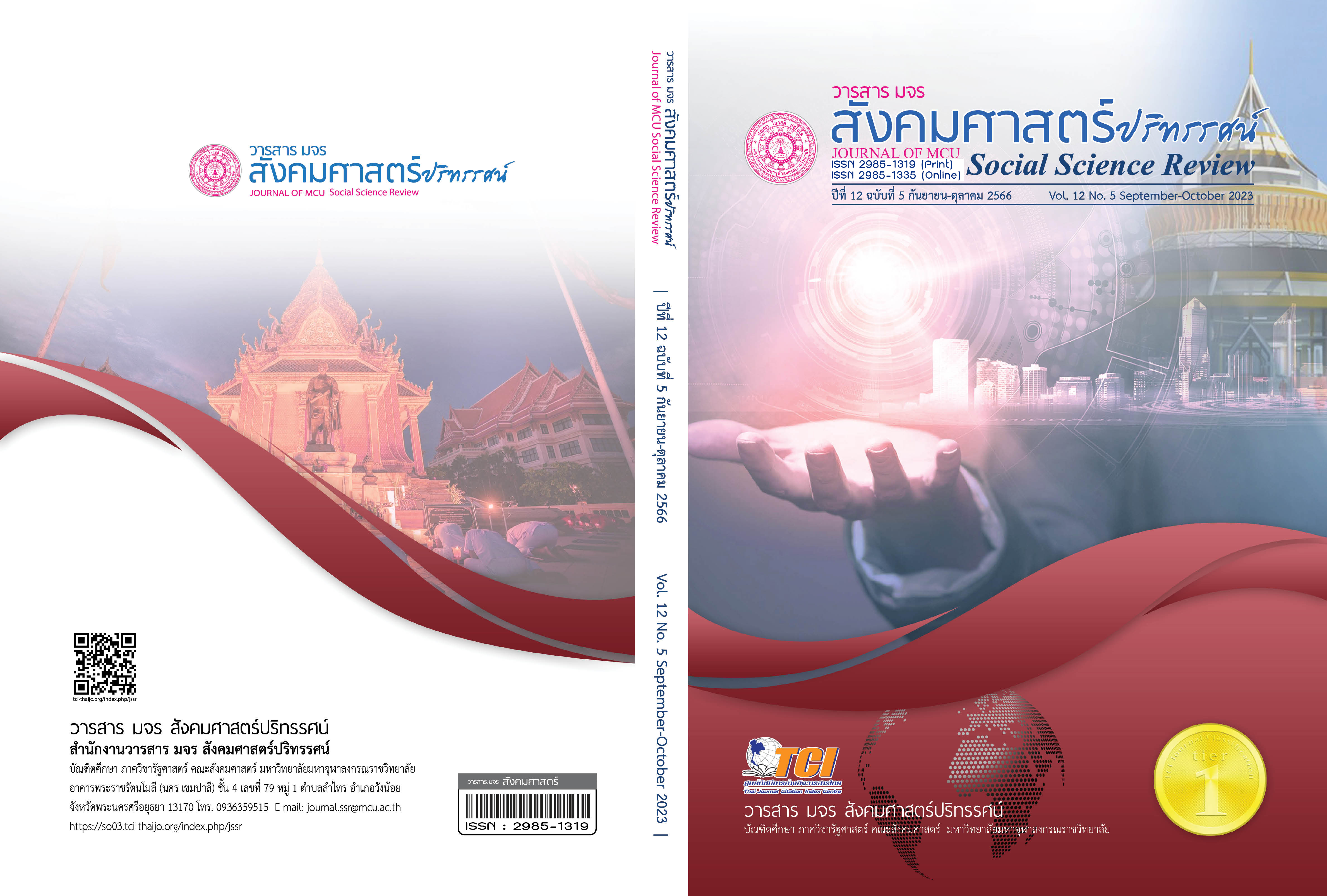ผลของรูปแบบการเสริมสร้างสุขภาพจิตวิถีใหม่สู่การดำเนินชีวิต วิถีถัดไปของเยาวชน
คำสำคัญ:
โปรแกรมการให้คำปรึกษากลุ่ม, สุขภาพจิต, เยาวชนบทคัดย่อ
บทความวิจัยนี้มีวัตถุประสงค์ 1. พัฒนารูปแบบการเสริมสร้างสุขภาพจิตวิถีใหม่สู่การดำเนินชีวิตวิถีถัดไปของเยาวชน ด้วยโปรแกรมการให้คำปรึกษาเชิงจิตวิทยาแบบกลุ่มบูรณาการ เป็นการวิจัยเชิงทดลอง โดยพิจารณาจากกลุ่มตัวอย่างที่มีคะแนนเฉลี่ยของสุขภาพจิต ตั้งแต่เปอร์เซ็นไทล์ที่ 25 ลงไป จากนั้นทำการสัมภาษณ์เยาวชนที่สมัครใจเข้าร่วมโปรแกรมกลุ่มตัวอย่าง คือ ประชาชนอายุ 15-25 ปี ในตำบลบ้านดู่ อำเภอเมือง จังหวัดเชียงราย จำนวน 60 คน การเก็บข้อมูลผลการทดลองใช้แบบสอบถามสุขภาพจิตของเยาวชนเปรียบเทียบค่าเฉลี่ยคะแนนสุขภาพจิตก่อน หลัง และติดตามผลการเข้าร่วมโปรแกรมด้วยการวิเคราะห์ความแปรปรวนแบบวัดซ้ำชนิดหนึ่งทาง วิเคราะห์เปรียบเทียบความแตกต่างรายคู่ และการทดสอบภายหลังของค่าเฉลี่ยสุขภาพจิตของเยาวชนโดยรวม และรายองค์ประกอบด้วยวิธี Least Significant Differences (LSD)
ผลการวิจัยพบว่า สัมพันธภาพภายในครอบครัว การเห็นคุณค่าในตนเอง การมีเป้าหมายชีวิต และสุขภาพจิต ระยะติดตามผลและหลังการทดลอง เยาวชนมีค่าเฉลี่ยปัจจัยเชิงสาเหตุสูงกว่าก่อนการทดลอง ส่วนติดตามผลมีค่าเฉลี่ยสูงกว่าหลังการทดลองอย่างมีนัยสำคัญทางสถิติที่ระดับ .01 ซึ่งผลต่างค่าเฉลี่ยคะแนนก่อน หลัง และติดตามผลการทดลองมีความแตกต่างกันอย่างมีนัยสําคัญทางสถิติ แสดงให้เห็นว่ารูปแบบการเสริมสร้างสุขภาพจิตวิถีใหม่สู่การดำเนินชีวิตวิถีถัดไปของเยาวชนมีประโยชน์และมีประสิทธิผลในการเสริมสร้างสุขภาพจิตของเยาวชน
เอกสารอ้างอิง
บีบีซี นิวส์. (2564). ฆ่าตัวตาย : ตัวเลขคนไทยปลิดชีพตัวเองไต่ระดับขึ้นระหว่างการระบาดของโควิด-19. สืบค้นเมื่อวันที่ 3 ตุลาคม 2565, จาก www.bbc.com/thai/thailand-57721370
ปริทรรศ ศิลปะกิจ และพันธุ์นภา กิตติรัตนไพบูลย์. (2560). แนวโน้มและปัจจัยที่มีผลต่อระดับสุขภาพจิตคนไทย: การสำรวจระดับชาติ ปี พ.ศ.2561. วารสารสุขภาพจิตแห่งประเทศไทย, 28(2), 121-135.
เยาวนารถ พันธุ์เพ็ง. (2564). การส่งเสริมสุขภาพของวัยรุ่นโดยใช้สื่อสังคมออนไลน์. วารสารสหศาสตร์ศรีปทุม ชลบุรี, 7(1), 21-29.
รมณภัทร กตตน์วงศกร. (2557). การศึกษาผลการพัฒนาทักษะชีวิตของนักเรียนชั้นประถมศึกษาปีที่ 6 โรงเรียนบางจาก (โกมลประเสริฐอุทิศ) สำนักงานเขตภาษีเจริญ กรุงเทพมหานคร (สารนิพนธ์การศึกษามหาบัณฑิต สาขาบริหารการศึกษา). กรุงเทพฯ: มหาวิทยาลัยศรีนครินทรวิโรฒ.
วงศกร สมัยเอี่ยม และคณะ. (2565). ผลของโปรแกรมการส่งเสริมสุขภาพโดยประยุกต์ตามทฤษฎีแรงจูงใจเพื่อป้องกันโรคต่อพฤติกรรมการจัดการความเครียดของนักเรียนชั้นมัธยมศึกษาปีที่ 1. วารสารมหาวิทยาลัยคริสเตียน, 28(2), 53-64.
สำนักงานสถิติแห่งชาติ. (2562). จำนวนประชากรจังหวัดเชียงราย. กรุงเทพฯ: สำนักงานสถิติแห่งชาติ.
สำนักงานสภาพัฒนาการเศรษฐกิจและสังคมแห่งชาติ. (2562). เยาวชนไทยเสี่ยงเป็นภาวะซึมเศร้า-ฆ่าตัวตายแนวโน้มสูงขึ้น. กรุงเทพฯ: สำนักงานสภาพัฒนาการเศรษฐกิจและสังคมแห่งชาติ.
สุปรีชา แก้วสวัสดิ์ และคณะ. (2562). การพัฒนาแนวทางการสร้างเสริมสุขภาพของเยาวชน ตำบลเกาะลิบง อำเภอกันตัง จังหวัดตรัง. วารสารวิชาการสาธารณสุข, 28(2). 31-42.
Clark, D. (2005). Catalogue of parametrictests. Encyclopedia of Statistics in Behavioral Science, 1, 207-227.
Golemiewski, R.T., & Blumberg, A. (1976). Learning and Change in Groups. London: Penguin Books.
Kelly, H.L. (2007). Randomized Clinical Effectiveness Trial of Nurse-Administered Small-Group Cognitive Behavior Therapy for Persistent Insomnia in General Practice. Sleep, 30(5), 574-584.
Lubin, B., & Eddy, W. (1970). The laboratory training model: rationale method and some thoughts for the future. International Journal of Group Psychotherapy, 20(3), 305-339.
Mawn, L. (2016). Getting it right! Enhancing youth involvement in mental health research. Health Expect, 19(4), 908 – 919.
McGorry, P.D., Mei, C., Chanen, A., & Hodges, C. (2022). Designing and scaling up integrated youth mental health care. World Psychiatry, 21(1), 61-76.
Sale, J. (2022). How innovative solutions can support and improve young people's mental health. Geneva: Word Economic Forum.
Stevens, M.H. (2002). Resource quantity, not resource heterogeneity, maintains plant diversity. Ecology Letters, 5(3), 420 – 426.
Taylor, A., et al. (2022). Defining research priorities for youth public mental health: reflections on a coproduction approach to transdisciplinary working. Health Research Policy and Systems, 20(1), 1-14.
Thomas, N. (2012). A randomised controlled trial of acceptance-based cognitive behavioural therapy for command hallucinations in psychotic disorders. Behaviour Research and Therapy, 50(2), 110-121.
ดาวน์โหลด
เผยแพร่แล้ว
รูปแบบการอ้างอิง
ฉบับ
ประเภทบทความ
สัญญาอนุญาต
ลิขสิทธิ์ (c) 2023 วารสาร มจร สังคมศาสตร์ปริทรรศน์

อนุญาตภายใต้เงื่อนไข Creative Commons Attribution-NonCommercial-NoDerivatives 4.0 International License.
เพื่อให้เป็นไปตามกฎหมายลิขสิทธิ์ ผู้นิพนธ์ทุกท่านต้องลงลายมือชื่อในแบบฟอร์มใบมอบลิขสิทธิ์บทความให้แก่วารสารฯ พร้อมกับบทความต้นฉบับที่ได้แก้ไขครั้งสุดท้าย นอกจากนี้ ผู้นิพนธ์ทุกท่านต้องยืนยันว่าบทความต้นฉบับที่ส่งมาตีพิมพ์นั้น ได้ส่งมาตีพิมพ์เฉพาะในวารสาร มจร สังคมศาสตร์ปริทรรศน์ เพียงแห่งเดียวเท่านั้น หากมีการใช้ภาพหรือตารางหรือเนื้อหาอื่นๆ ของผู้นิพนธ์อื่นที่ปรากฏในสิ่งตีพิมพ์อื่นมาแล้ว ผู้นิพนธ์ต้องขออนุญาตเจ้าของลิขสิทธิ์ก่อน พร้อมทั้งแสดงหนังสือที่ได้รับการยินยอมต่อบรรณาธิการ ก่อนที่บทความจะได้รับการตีพิมพ์ หากไม่เป็นไปตามข้อกำหนดเบื้องต้น ทางวารสารจะถอดบทความของท่านออกโดยไม่มีข้อยกเว้นใดๆ ทั้งสิ้น





